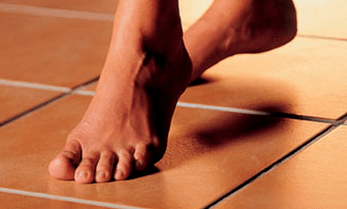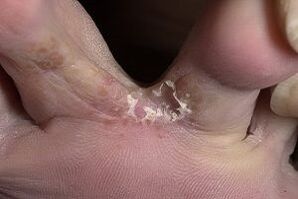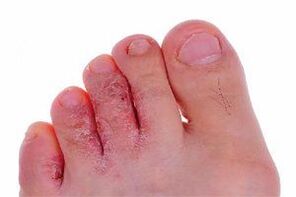If a person has fungus on their feet, it is important to start treatment promptly and adequately. The fact is that the fungal disease of the skin of the feet is contagious and if you do not start fighting the disease immediately, all members of the patient's family are at risk of infection. Treatment will be prescribed by a doctor, it will depend on the type of pathology, the degree of skin damage, as well as the general condition of the person.

Causes of fungus on the feet
The fungus does not always cause mycoses on the skin of the feet, and in order for the first symptoms to appear, negative factors must act on the human body. The following negative factors affect the development of mycosis:

- Weakening of the body's immune forces;
- Use of heavy and toxic drugs;
- Non-compliance with the rules of foot and toe hygiene;
- The presence of cracks, wounds and abrasions on the fingers and toes through which fungal spores can enter the body.
Wet floor areas for fungal infections include swimming pools, baths, and showers in gyms.
Fungal infection enters the body through contact-household, when an adult or child comes into contact with a sick carrier or objects inhabited by fungal spores. Foot fungus can often be collected in public places - in dressing rooms, showers, swimming pools, on the beach. The disease can also be transmitted by wearing someone else’s shoes on which pathogen spores live. Failure to follow the rules of basic hygiene leads to undesirable consequences, leading to fungal pathologies of the foot and toenails. The carrier may not always be able to find out in time that he has foot fungus because the symptoms are manifested only in a combination of unfavorable circumstances. But such a person is still contagious and it is dangerous for loved ones who are also at risk of contracting an infection.
Symptoms and types
Ankle mycosis is the following forms:
- Quasimous;
- Dihydrosal;
- intertriginous;
- Onychomycosis;
- Candidiasis.
Flat
The initial symptoms of this form of fungus are found in only one foot, however, with the progression of the pathology, the manifestation is observed in the other foot. The disease resembles a skin defect on which inflammation forms, covered with peeling. Flat foot fungus is not always characterized by itching and discomfort, so for many this disease goes unnoticed and its detection is impossible without laboratory research.
If the foot fungus is not cured in time, the infectious lesion moves to the shin, then the problem will be much harder to deal with. Also, the fungus can be localized on calves, although these complications are rare.
Dihydrosis
The first signs of fungus on the feet of this shape are characterized by the formation of bubbles on the arch of the foot, which gradually increase in size and reach a diameter of up to 10 mm. It hurts after opening the rash, erosion occurs in its place. The sites of injury are sore, there are cases of bacterial inflammation. After healing the skin on the affected areas the disease goes into a flat form. In the dihydrosis variety, the skin on both feet is rarely damaged; if timely treatment is not started, a neglected form develops in which the remission stages change with exacerbation.
intertrigous

Foot intertrigenous or interstitial fungus is the most common form of skin disease.
This type of foot fungus is considered to be the most common. The skin between the 4th and 5th fingers is most often grazed. The disease manifests itself in the form of dead, scaly areas that exfoliate from the normal layer of the epidermis.
If you do not help in time, then the peeling areas begin to get wet, the patient feels pain and itching. In addition, wounds and erosions occur in the damaged areas, which are difficult to repair.
If you do nothing and ignore the symptoms, the disease progresses to a chronic form that is prone to frequent relapses.
Onychomycosis
The disease is characterized by the fact that the fungus is localized on the nails and fingers. First the fungus on the toenails manifests itself in the form of damage to the free edge of the nail, on which yellowish spots and streaks form. There are the following types of nail and toe fungi:
- Hypertrophic. The nail plate thickens, turns yellow, is easily destroyed. Damaged skin of the finger can be seen under the damaged foci.
- Atrophic. The nail is thinned, quickly destroyed and the dermis beneath it is keratinized.
- Onychomycosis caused by fungi. The nail plate is thinned, its color becomes black, brown, yellowish or green. The disease is a complication of the previous 2 types of pathology.
Candida

The fungus infects the skin between the toes, causing bacterial infection without proper treatment.
This type of disease is caused by yeast-like pathogenic fungi called Candida. Foci of inflammation are often localized on the skin between 3 and 4 or 4 and 5 fingers. Tissues in these areas become inflamed, swelling develops, and is often accompanied by a bacterial complication.
Candida fungus is a species of microorganism that damages the oral mucosa and outer skin. Candidiasis is usually present in limited quantities in the human body. However, with impaired immunity, it can show increased activity, causing discomfort to the patient.
If the fungus is not removed in the initial stage, pustules, cracks and erosions will appear, which are difficult to get rid of even with the help of strong medicines.
Diagnostic methods
In order for fungus treatment on the feet to be effective, it is important to identify the cause and make an accurate diagnosis. For this it is worth a visit to the doctor, who will often be able to determine the pathology after the first visual examination. If the skin pathology looks suspicious or does not disappear for a long time, blood and urine tests will be needed, as well as additional diagnostic tests to help determine the types of pathogens and their susceptibility. Antifungal drugs. For this, a part of the dermis is taken from the damaged area and viewed under a microscope. To examine malignant cells in tissues, samples are taken from the damaged areas for biopsy.
What should I treat?

There are many fungal diseases, laboratory tests are performed to determine their difference and correct treatment.
To cure foot fungus and prevent recurrence, you should contact a healthcare professional for advice and take diagnostic steps. If the diagnosis is made correctly, you can start therapy that uses drugs with systemic and local effects.
Effective in the initial stage of treatment, then during the therapy period you can get external means in the form of creams, ointments and sprays. It is also possible to treat foot fungus at home. If the disease has damaged the deep layers of the dermis and nail plates, it is recommended to use a systemic drug to fight the fungus.
Treatment with folk remedies is effective only with the use of medication, otherwise the disease threatens to develop dangerous complications.
Treatment with medication
An effective and efficient medication should be prescribed by a doctor. If you self-medicate and ignore the advice of a specialist, you can provoke serious complications that the most effective remedy can not deal with immediately.
Therapy with folk remedies
Treatment of foot fungus with folk remedies at home should be agreed with your doctor. It is important to know that strong medications are used to treat foot and nail fungus, folk remedies are allowed as adjunctive therapy because it is ineffective in fighting the disease in your own home. There are various recipes that use medicinal herbs that have antimicrobial, disinfectant and wound healing properties. Folk remedies against fungus are available and cheap, but which home method is better to use and which recipe is suitable in a particular case, you should consult a doctor. The best recipes are given below:
- Decoction with herbs chamomile, plantain and heirloom. Mix the ingredients, take 1 s each. K. L. Pour everything into a saucepan and pour 1 liter of hot water, bring to a boil and leave for 10 minutes before boiling. After taking the broth, squeeze and wash the affected hands, feet and other parts of the body before going to bed. The essence of the procedure is to conduct it regularly, then this method will be effective and will help the fungus to heal faster.
- Infusion of onion and St. John's wort. Peel an onion and press into 4 parts. St. John's wort must be dried. Onions and 50 g of wort pour 2, 5 liters of boiling water. Wrap the container with raw materials and refrigerate for one day. In the evening, apply a compress to the affected areas from the infusion.
Prevention
The best preventative measure in the fight against fungus, which can prevent disease, is to strengthen the protective properties of the body. This method is cheap, but the most effective and efficient. Medication and alternative methods of treatment should be agreed with your doctor, any self-medication can lead to dangerous complications that are more difficult and time consuming to deal with.































